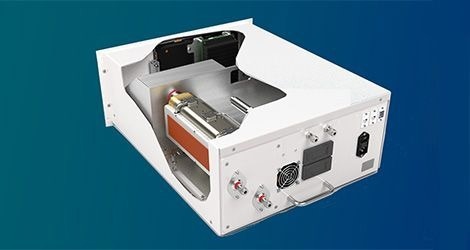 Interview conducted by Mychealla RiceNov 10 2022
Interview conducted by Mychealla RiceNov 10 2022Many industrial processes and manufacturing applications require ultra-precise gas analysis techniques to improve efficiency, quality, and safety within the workplace and across products. However, traditional methods such as gas chromatography (GC) and GC mass spectrometry (GC-MS) are often slow with results and expensive to maintain.
To overcome this, Thermo Fisher has developed a new technology in the Thermo Scientific™ MAX-iR™ FTIR Gas Analyzer. This new analyzer can achieve single-digit parts-per-billion (ppb) to parts-per-trillion (ppt) detection limits in real-time industrial scenarios.
In this interview, AZoM speaks with Kelly McPartland from Thermo Fisher Scientific to discover more about the main advantages of the MAX-iR Gas Analyzer and what sets it apart from other gas analysis systems.
Could you provide an overview of FTIR-based gas analysis?
Fourier transform infrared (FTIR) spectroscopy is a robust quantitative and qualitative analytical method which can measure many gases with a rapid response and detection limits in the low parts-per-million (ppm).
The theory behind FTIR analysis is that each compound has a unique chemical structure that produces a specific infrared absorbent spectrum based on the vibration, stretching, and bending of chemical bonds.
The spectrum always remains the same, but the intensity of those absorbance bands changes with concentration, allowing researchers to generate calibrations for each unique component and analyze various components in a complex gas matrix.

Image Credit:Shutterstock/Seventyfour
What are the main advantages and limitations of FTIR analysis?
The primary advantage of FTIR is that it enables constant calibration. In addition, it enables instrument-to-instrument calibration transferability.
If the sample pressure and temperature are maintained at the calibration temperature and pressure, a quantitative spectral library can be used across all of the same FTIR gas analyzers and for the lifetime of the analyzers. There is no need to recalibrate in the field.
Traditionally, there has been one limitation with FTIR gas analysis that has kept it from being widely used for industrial applications: sensitivity. Industrial users often need detection limits down to ppb or ppt, and that has been unattainable by FTIR until very recently.
What advantages does FTIR have over the other forms of gas analysis?
FTIR is ideal for process or emissions monitoring. One of the main advantages is speed. There is constant flow through the gas cell, and the gas is constantly probed with an IR beam. This allows a user to obtain real-time results. With other traditional gas analysis techniques such as gas chromatography (GC), the user is typically required to collect a batch sample, transport it, analyze it, wait for a result, feed the result back into their operations, and then repeat that process.
Compared to GC, there is a relatively low cost of ownership because the FTIR analyzer requires minimal maintenance and no consumables. Also, the FTIR analyzer doesn’t require calibration, so it can be operated by engineers in the field rather than analytical chemists in a lab. Furthermore, FTIR analysis has a wider dynamic range. For example, certain GC detectors like GC-MS often require sample splitting or dilution because there is a risk of saturating the signal when analyzing high concentrations.
Conversely, with FTIR, many different bands can be used for analysis. This allows concentrations to be measured from a high percentage all the way down to the ppb range. Additionally, users can acquire structural information and speciate isomers, which mass spectrometry cannot do. Therefore, FTIR is well-suited for both field and process applications due to its robustness and the minimal maintenance it requires. It’s designed to run for years without user intervention.
What advantages does the MAX-iR FTIR gas analyzer platform have over other systems?
The MAX-iR analyzer is a fully-optimized system for gas analysis with an extremely high optical throughput and a 10-meter multi-pass gas cell, which makes it inherently more sensitive than other FTIR gas analyzers. The MAX-iR analyzer is also offered with optical enhancement (OE) technology called Thermo Scientific™ StarBoost™ Technology, which dramatically enhances the analyzer’s signal-to-noise ratio (SNR) over a narrower spectral range. This OE-FTIR technology is disruptive because it has all the advantages of traditional FTIR plus detection limits that rival GC-MS. This is only available through Thermo Fisher on the MAX-iR gas analyzer platform.
Another key advantage of the MAX-iR platform is that there is no requirement for liquid nitrogen. Many FTIR analyzers use mercury cadmium telluride (MCT) detectors that require liquid nitrogen cooling. The MAX-iR analyzer uses either a deuterated triglycine sulfate (DTGS) detector, a thermoelectrically-cooled indium arsenide (TE-InAs) detector, or a TE-MCT detector.
The MAX-iR platform comes with a powerful software package that enables automation of data acquisition and reporting. The software includes a quantitative gas library, which makes it easy for customers to switch between methods or develop their own.

Why is the MAX-iR FTIR gas analyzer an appropriate choice for industrial environment applications?
In addition to the MAX-iR analyzer’s previously mentioned robustness and real-time results, the Thermo Scientific™ MAX Analytical™ Software Suite, in particular, makes the analyzer an ideal choice for industrial and process environments due to the automation and factory integration capabilities.
The software allows the MAX-iR analyzer to be controlled remotely via Modbus or digital inputs. It also has many data publishing capabilities to integrate with a factory data collection system. The software has a series of alarms and alerts for hardware diagnostics and gas concentration limits.
This means that the software will warn the user of upcoming preventative maintenance issues, making it an extremely proactive system. Rather than waiting for something to become a problem, users will receive an early warning so downtime can be prevented.
Overall, the software makes it easy to integrate the MAX-iR system into an industrial environment. The system can be run for years without intervention, and users will be alerted to any hardware issues or gas concentration alarms.

Image Credit:Shuttershock/GertLavsen
What are the current challenges in industrial gas analysis, and how does the MAX-iR platform help industry to overcome them?
In addition to uptime, sensitivity is the main challenge. Historically, FTIR gas analysis was only able to achieve detection limits in the low ppm range. Therefore, upon comparing GC-MS to FTIR, users might have chosen to employ GC-MS because it was far more sensitive.
The MAX-iR analyzer with StarBoost technology overcomes the sensitivity challenge because it can efficiently analyze multiple gases down to single digit ppb and even mid ppt levels in real time.
Which industries rely on ultra-sensitive gas analysis?
The semiconductor industry is one of the main industries that rely on ultra-sensitive gas analysis, which we now provide with OE-FTIR. Many other industries, such as chemical manufacturing, also require high sensitivity in their gas analysis applications.
In addition, ultra-sensitive gas analyzers are essential for monitoring hazardous air pollutants (HAPs) in environmental health and safety (EH&S) applications and for emissions monitoring such as measuring greenhouse gases. OE-FTIR technology can provide a more cost-effective and timely solution for all these ultra-sensitive gas analysis applications.
How is gas analysis relevant to the production of semiconductors in the semiconductor industry?
Semiconductor manufacturing involves the deposition of compounds onto a silicon wafer, and ultra-high purity gases are required to keep those operations efficient and the environment clean. For example, semiconductor manufacturing uses ultra-high purity nitrogen to purge gas distribution channels.
Oxygen is critical to the deposition reactions because it oxidizes silicon to silicon oxide. Helium is also used in the semiconductor industry as a refrigerant, and argon is critical because it provides an inert environment for the deposition reaction to occur.
Each of these bulk gases (nitrogen, oxygen, helium, argon) must be ultra-high purity for the semiconductor production processes to function efficiently.

Image Credit: Thermo Fisher Scientific
Why should semiconductor manufacturers use the MAX-iR platform?
Semiconductor manufacturers will want to use the platform primarily due to its sensitivity. The MAX-iR analyzer’s optical enhancement technology, StarBoost, makes it one of the most sensitive FTIR gas analysis systems on the market today.
Cavity ring-down spectroscopy (CRDS) is often used for the analysis of impurities in the semiconductor industry, but the main advantage for users of the MAX-iR system is that, unlike CRDS, it can analyze many impurities with a single analyzer.
Semiconductor manufacturers may currently use individual analyzers for CO, CO2, total hydrocarbon, moisture, methane, etc. With the MAX-iR platform, they can measure all of those gases simultaneously with a single analyzer, saving time and cost.
Has the increased need for emission monitoring influenced the platform’s development?
Yes, heightened interest in emission monitoring has absolutely helped shape the platform’s development. The MAX-iR analyzer with StarBoost technology was originally developed to address challenges in emission monitoring in environmental analysis. A primary example is measuring low levels of formaldehyde in turbine emissions to meet the US Environmental Protection Agency’s (EPA) YYYY regulation.
This regulation requires an emissions limit of 91 ppb of formaldehyde, which is a very low concentration. However, the flow is very high from turbines, so even a low concentration may result in a high mass emission. Previously, no analytical technique could reliably measure at such low levels.
As a result, offline techniques were regularly used, such as method TO-11A, which involved wet chemistry. While an FTIR system could have allowed the user to receive results in the field in real-time, previous FTIR technology did not have the precision required to achieve a reliable pass-fail at 91 ppb.
The StarBoost optical enhancement was developed specifically to drive down the FTIR analyzer detection limits for formaldehyde analysis. Using this improvement, the MAX-iR analyzer with StarBoost technology can measure formaldehyde down to < 10 ppb, meaning that users can now confidently tell whether emissions results pass or fail at 91 ppb.
What were the main challenges faced during the MAX-iR system’s development?
When we started developing an ultra-sensitive OE-FTIR system, the first way we sought to increase the sensitivity involved the spectral range. Initially, we thought we needed an ultra-narrow bandpass, which limited the number of gases that could be measured.
As the MAX-iR platform matured, we were able to expand the spectral range with StarBoost technology without sacrificing sensitivity. With the latest version of the system, users can measure many gases and still achieve single-digit ppb detection limits. The main challenge has been optimizing the spectral range of the system without impacting the sensitivity.
What advances and improvements are planned for the platform in the future?
We are always expanding the MAX-iR system’s quantitative spectral library to allow users to measure more and more gases. We are also constantly improving the MAX Analytical Software Suite package to improve the user experience.
We will also broaden the analyzer’s application in various industries to help solve different types of gas analysis problems. Aside from semiconductor manufacturing, I believe there is plenty of additional opportunity within the petrochemical industry, industrial process monitoring, and, potentially, greenhouse gas monitoring.
About Kelly McPartland 
Kelly McPartland is an Applications Manager with Thermo Fisher Scientific, Gas Analysis Solutions. A graduate of Boston University, Kelly is an expert in FTIR gas analysis, associated method development and data validation. As a senior-level technical liaison for gas analysis customers, Kelly has been a key architect and manager for data acquisition gas analysis software, ensuring quality results and customer usability. Kelly also works closely with state and federal regulatory agencies to develop Quality Assurance Plans and test methods for new technologies.
Kelly’s expertise in FTIR gas analysis, which spans hardware systems to method development and data validation, stems from her liaison work with customers as well as regulatory agencies.

This information has been sourced, reviewed and adapted from materials provided by Thermo Fisher Scientific.
For more information on this source, please visit Thermo Fisher Scientific.
Disclaimer: The views expressed here are those of the interviewee and do not necessarily represent the views of AZoM.com Limited (T/A) AZoNetwork, the owner and operator of this website. This disclaimer forms part of the Terms and Conditions of use of this website.